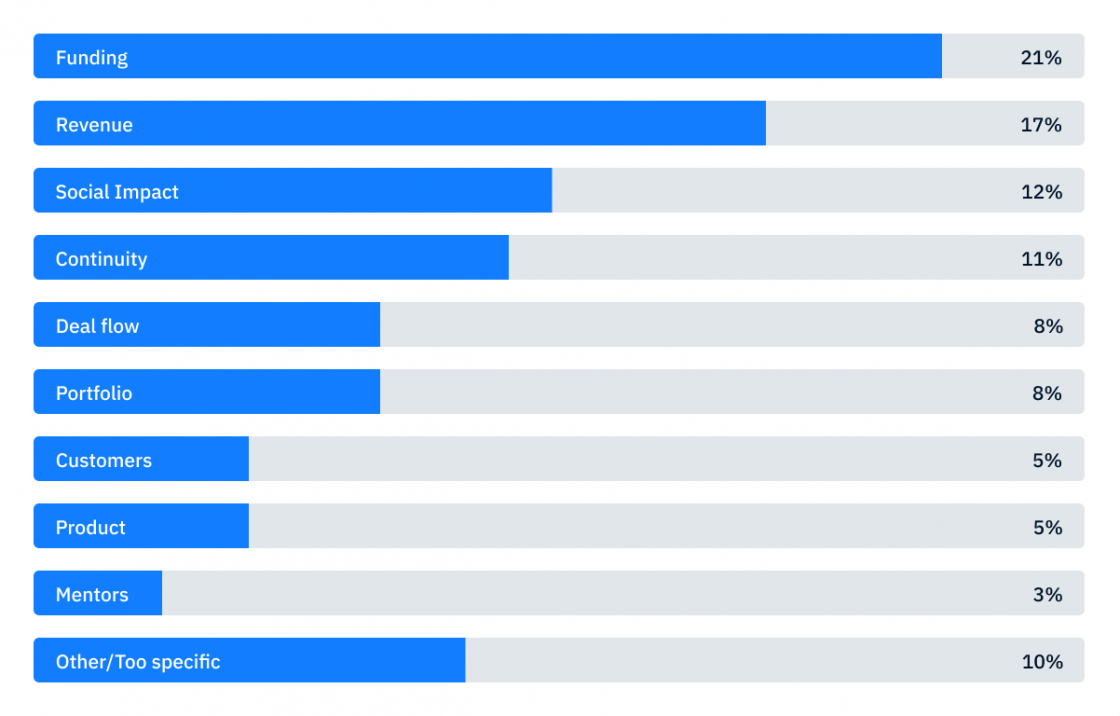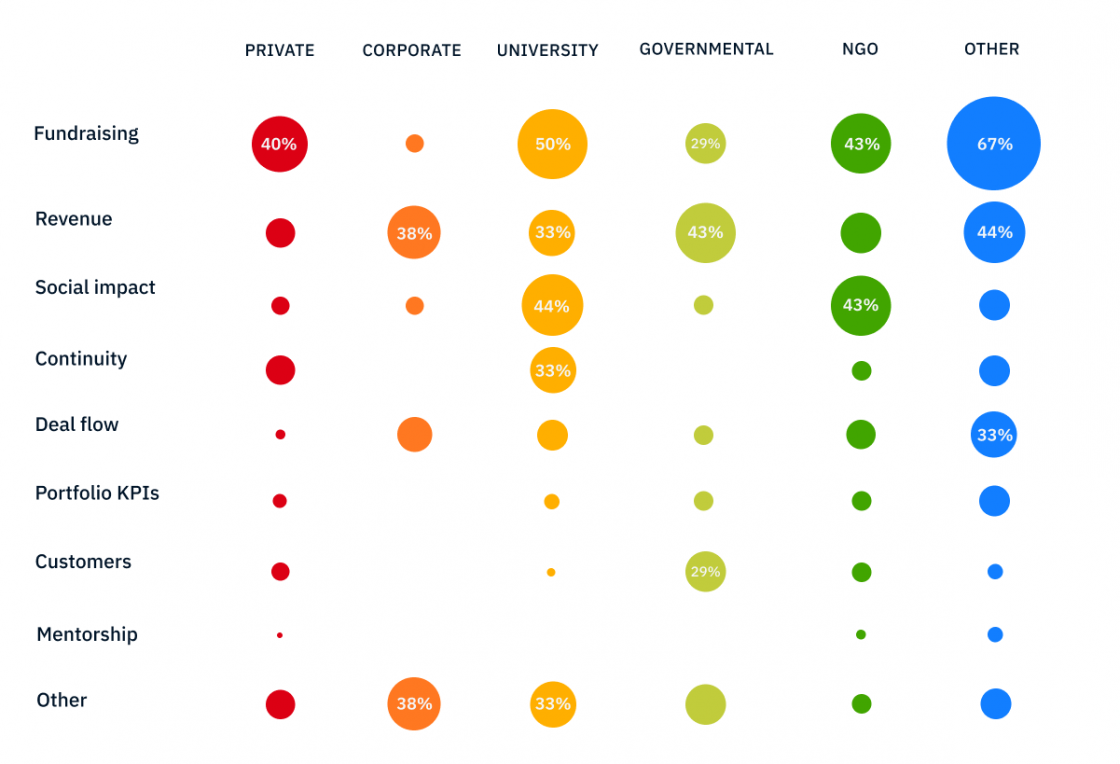Accelerators live and breathe startup metrics. They set the KPIs (key performance indicators — the most important metrics) that startups should report and try their best to teach them how to execute everything based on metrics. But how do accelerators fare on this themselves? How do they measure their success and report it to their stakeholders? What are the important accelerator metrics KPIs?
The status quo of accelerator metrics KPIs
Accelerators that track startup exits, funding, survival rates, and others, as part of their KPIs, depend on tracking startup progress after a program. Tracking and reporting are easy for those taking in small cohorts and offering them office space. They are in constant contact due to proximity. Consequently, not having a system in place is rarely an issue. Keeping track of five startups’ progress with spreadsheets works just fine. But it is not an efficient solution for accelerators working with larger cohorts or looking to scale up.
Accelerator KPIs should be closely related to the purpose of the accelerator
To choose the correct KPIs for an accelerator, you must go back to basics. You must remember why an accelerator exists in the first place, and bear in mind a very clear definition of success. But what is success?
For each accelerator, success has a different meaning. Because each has a unique reason for existing. Still, if you take a closer look at all accelerators, you discover they share several values or objectives. Let us look at some of the common ones:
- increase the number of startups or tech companies in the region;
- connect startups with corporations looking for innovation;
- change the local economic culture;
- help launch more companies founded by students;
- help with corporate or university marketing;
- drive innovation around a certain technology;
- access revenue for innovation in certain areas.
The reason an accelerator exists and its business model impact the way it selects and measures its KPIs. Some accelerators (in very rare cases) charge startups a fee, so they can have skin in the game, others take equity and depend directly on the success of the startup, and some rely on government funding to drive positive change. Naturally, they all report different accelerator metrics KPIs to their stakeholders.
Choosing relevant accelerator metrics KPIs
Metrics reported by accelerators usually depend on who their stakeholders are. University, private, corporate, NGO, and government programs have different types of metrics as their stakeholders look for different things in the data. As you can imagine, two accelerators will rarely end up using the same KPIs or reporting systems.

For private and corporate accelerators, success might mean revenue. If this is the case, relevant metrics could focus on how many startups achieved enough revenue to leave the accelerator. For a fair comparison, accelerators must know how fast the average startup reaches that revenue on its own. And how much faster this happens through the accelerator’s program.
For university and NGO accelerators, success might have a different meaning when it comes to success metrics. University accelerators might be interested in vanity numbers, like how many startups apply to their programs. While NGO accelerators might focus on the number of jobs created by startups.
The most common types of metrics tracked by accelerators are:
- Decision (immediate). They are used to drive decisions in key moments, especially when time is of the essence. Immediate metrics are there to maximize the output of the decision.
- Performance (lagging). They are used to inform and see how operations evolve, usually monthly, quarterly, or yearly. Lagging metrics help discover, understand, and predict future trends.
- Vanity. These metrics are the best looking ones. They are commonly used for PR purposes,
- Compliance. They are the ones that keep stakeholders satisfied. They often fall in the performance or vanity categories.
Findings
Our research shows that KPIs reported by accelerators are related more to startup performance than to accelerator performance. Perhaps accelerators should take a page from what they teach startups and take a harder look at their data. How do investments perform? What social impact does the program have? Also, if startups track user acquisition and performance KPIs, maybe accelerators should look at metrics related to their acquisition funnel, their performance, deal flow acquisition costs, etc.
The more an accelerator wants to scale, the more complex the data it tracks and reports will be. The old ways of tracking KPIs result solely in overhead and excessive spreadsheet usage. Change is imminent. Developing universal KPIs for accelerators can seem complicated due to their different purposes. But it is not mission impossible. It only requires perseverance, discipline, and the right tools.
Thoughts
- Starting an accelerator should be like starting any other business. It is all about defining a strategy (background, objectives, strategic approach, monitoring & KPIs). Accelerators that struggle with choosing success metrics (KPIs) should focus on three simple pillars: why, what and how. These pillars often trump complex management or strategy consulting frameworks, and they are a great way to ensure that all the stakeholders are aligned from the start, that the brand of the accelerator is built with consistency across all messages, and that everyone in the team works toward the same end goal. Watch Simon Sinek’s TED talk, which is a very inspiring way to think about clarifying your strategy.
- “Why” is the critical strategic part and the part that gets skipped most often, to get down to the tactical (“What”) and operational (“Why”). One aspect that should not be ignored is that an accelerator is often a startup organization with lots of assumptions, unknowns, and perils. Therefore, its success lies first and foremost in the “whys” of the accelerator champions (which can be its founders or key stakeholders). Here, strategy is about honesty. One thing is clear: being an accelerator manager is more often than not an underpaid job. People who take on this responsibility have different motivations. If these are not aligned with the ones of the other stakeholders, before being aligned with the accelerator’s “why”, the risk of internal conflict or inability to follow the strategy will be greater. Additionally, do not forget about the assets or competitive advantages the accelerator has at its disposal (capital, know-how, relationships, ecosystem, etc).
- “What” takes into account the broad lines of the tactical approach. This will define the format (accelerator, incubator, fund), focus (education, knowledge transfer, impact, growth, fundraising) and resources needed. Accelerators should also be honest about how they measure reaching their goals and why they need to look at their data. This “why” should carry infinitely more weight than the pleasure of measuring.
- “How” gets into more detail about decisions and actionability, and details the actions and planning to reach the objectives from the previous point. If the previous two are flawed, the chances of these actions leading to excellent results (but not the right outcomes) increase.
- The old ways of tracking accelerator metrics KPIs in spreadsheets will not work forever. If accelerators want to scale up or become more efficient, a system (other than spreadsheets and forms) is essential, as a lot of accelerators measuring success is linked to getting the KPIs of each company. As we discovered, this is a huge challenge for more than 42% of accelerators.

Conclusion
Running an accelerator is no easy job. On the one hand, startups are high maintenance. You have to manage expectations and potential conflicts with startup founders, you have to create an environment where they thrive and make sure they get all the resources they need to achieve success. In addition, getting startups to track and report their metrics is a tough job. On the other hand, you have to manage the expectations and demands of your stakeholders, regardless of accelerator type. Surely simplifying the one part you can actually control (your own KPIs) will have a positive impact on your accelerator.
Accelerator management tool
- Streamline your deal flow
- Keep all information and communication in one place
- Connect your mentors and founders, and more...